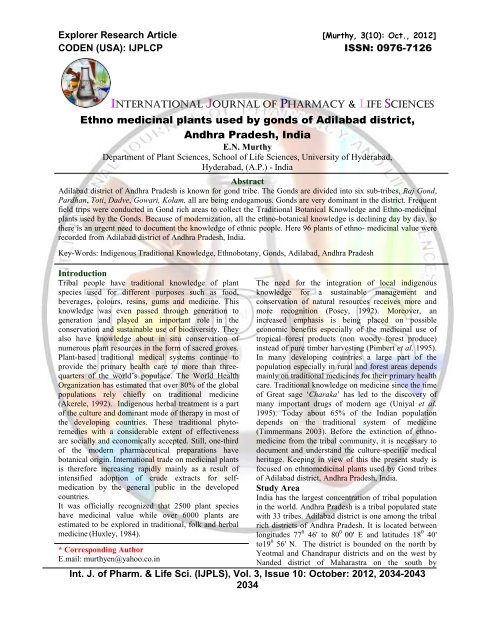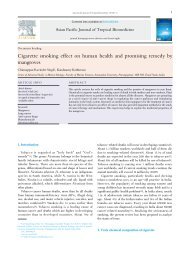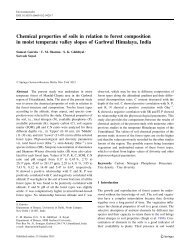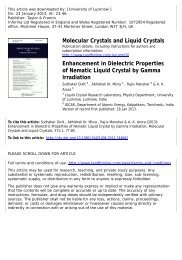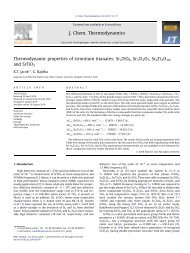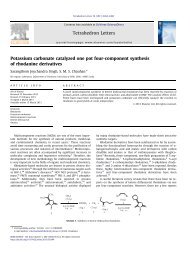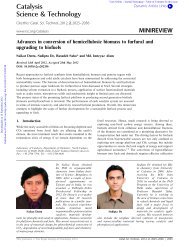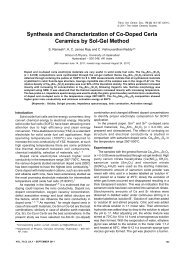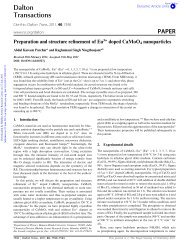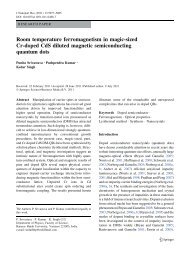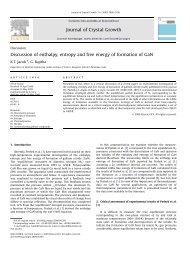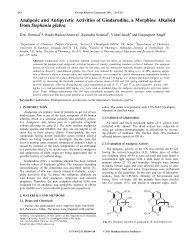Ethno medicinal plants used by gonds of Adilabad district, Andhra ...
Ethno medicinal plants used by gonds of Adilabad district, Andhra ...
Ethno medicinal plants used by gonds of Adilabad district, Andhra ...
- No tags were found...
You also want an ePaper? Increase the reach of your titles
YUMPU automatically turns print PDFs into web optimized ePapers that Google loves.
Explorer Research Article [Murthy, 3(10): Oct., 2012]CODEN (USA): IJPLCP ISSN: 0976-7126INTERNATIONAL JOURNAL OF PHARMACY & LIFE SCIENCES<strong>Ethno</strong> <strong>medicinal</strong> <strong>plants</strong> <strong>used</strong> <strong>by</strong> <strong>gonds</strong> <strong>of</strong> <strong>Adilabad</strong> <strong>district</strong>,<strong>Andhra</strong> Pradesh, IndiaE.N. MurthyDepartment <strong>of</strong> Plant Sciences, School <strong>of</strong> Life Sciences, University <strong>of</strong> Hyderabad,Hyderabad, (A.P.) - IndiaAbstract<strong>Adilabad</strong> <strong>district</strong> <strong>of</strong> <strong>Andhra</strong> Pradesh is known for gond tribe. The Gonds are divided into six sub-tribes, Raj Gond,Pardhan, Toti, Dadve, Gowari, Kolam, all are being endogamous. Gonds are very dominant in the <strong>district</strong>. Frequentfield trips were conducted in Gond rich areas to collect the Traditional Botanical Knowledge and <strong>Ethno</strong>-<strong>medicinal</strong><strong>plants</strong> <strong>used</strong> <strong>by</strong> the Gonds. Because <strong>of</strong> modernization, all the ethno-botanical knowledge is declining day <strong>by</strong> day, sothere is an urgent need to document the knowledge <strong>of</strong> ethnic people. Here 96 <strong>plants</strong> <strong>of</strong> ethno- <strong>medicinal</strong> value wererecorded from <strong>Adilabad</strong> <strong>district</strong> <strong>of</strong> <strong>Andhra</strong> Pradesh, India.Key-Words: Indigenous Traditional Knowledge, <strong>Ethno</strong>botany, Gonds, <strong>Adilabad</strong>, <strong>Andhra</strong> PradeshIntroductionTribal people have traditional knowledge <strong>of</strong> <strong>plants</strong>pecies <strong>used</strong> for different purposes such as food,beverages, colours, resins, gums and medicine. Thisknowledge was even passed through generation togeneration and played an important role in theconservation and sustainable use <strong>of</strong> biodiversity. Theyalso have knowledge about in situ conservation <strong>of</strong>numerous plant resources in the form <strong>of</strong> sacred groves.Plant-based traditional medical systems continue toprovide the primary health care to more than threequarters<strong>of</strong> the world’s populace. The World HealthOrganization has estimated that over 80% <strong>of</strong> the globalpopulations rely chiefly on traditional medicine(Akerele, 1992). Indigenous herbal treatment is a part<strong>of</strong> the culture and dominant mode <strong>of</strong> therapy in most <strong>of</strong>the developing countries. These traditional phytoremedieswith a considerable extent <strong>of</strong> effectivenessare socially and economically accepted. Still, one-third<strong>of</strong> the modern pharmaceutical preparations havebotanical origin. International trade on <strong>medicinal</strong> <strong>plants</strong>is therefore increasing rapidly mainly as a result <strong>of</strong>intensified adoption <strong>of</strong> crude extracts for selfmedication<strong>by</strong> the general public in the developedcountries.It was <strong>of</strong>ficially recognized that 2500 plant specieshave <strong>medicinal</strong> value while over 6000 <strong>plants</strong> areestimated to be explored in traditional, folk and herbalmedicine (Huxley, 1984).* Corresponding AuthorE.mail: murthyen@yahoo.co.inThe need for the integration <strong>of</strong> local indigenousknowledge for a sustainable management andconservation <strong>of</strong> natural resources receives more andmore recognition (Posey, 1992). Moreover, anincreased emphasis is being placed on possibleeconomic benefits especially <strong>of</strong> the <strong>medicinal</strong> use <strong>of</strong>tropical forest products (non woody forest produce)instead <strong>of</strong> pure timber harvesting (Pimbert et al. 1995).In many developing countries a large part <strong>of</strong> thepopulation especially in rural and forest areas dependsmainly on traditional medicines for their primary healthcare. Traditional knowledge on medicine since the time<strong>of</strong> Great sage ‘Charaka’ has led to the discovery <strong>of</strong>many important drugs <strong>of</strong> modern age (Uniyal et al.1995). Today about 65% <strong>of</strong> the Indian populationdepends on the traditional system <strong>of</strong> medicine(Timmermans 2003). Before the extinction <strong>of</strong> ethnomedicinefrom the tribal community, it is necessary todocument and understand the culture-specific medicalheritage. Keeping in view <strong>of</strong> this the present study isfoc<strong>used</strong> on ethno<strong>medicinal</strong> <strong>plants</strong> <strong>used</strong> <strong>by</strong> Gond tribes<strong>of</strong> <strong>Adilabad</strong> <strong>district</strong>, <strong>Andhra</strong> Pradesh, India.Study AreaIndia has the largest concentration <strong>of</strong> tribal populationin the world. <strong>Andhra</strong> Pradesh is a tribal populated statewith 33 tribes. <strong>Adilabad</strong> <strong>district</strong> is one among the tribalrich <strong>district</strong>s <strong>of</strong> <strong>Andhra</strong> Pradesh. It is located betweenlongitudes 77 0 46' to 80 0 00' E and latitudes 18 0 40'to19 0 56' N. The <strong>district</strong> is bounded on the north <strong>by</strong>Yeotmal and Chandrapur <strong>district</strong>s and on the west <strong>by</strong>Nanded <strong>district</strong> <strong>of</strong> Maharastra on the south <strong>by</strong>Int. J. <strong>of</strong> Pharm. & Life Sci. (IJPLS), Vol. 3, Issue 10: October: 2012, 2034-20432034
Explorer Research Article [Murthy, 3(10): Oct., 2012]CODEN (USA): IJPLCP ISSN: 0976-7126Karimnagar and Nizamabad <strong>district</strong>s <strong>of</strong> <strong>Andhra</strong>Pradesh (Fig 1). The <strong>district</strong> has 52 mandals which aregrouped into five revenue divisions, viz. <strong>Adilabad</strong>,Utnur, Nirmal, Mancherial and Asifabad. The mostimportant river that drains in the <strong>district</strong> is Godavariwith its tributaries Penganga, Wardha, Pranahita,Kadem and Pedavagu. The <strong>district</strong> occupies fifthposition with the extent <strong>of</strong> an area, i.e. 16,203.8 sq kmwhich accounts for 5.9% <strong>of</strong> total geographic area <strong>of</strong><strong>Andhra</strong> Pradesh (Anoymous, 1975). It is the secondlargest <strong>district</strong> in Telangana region. Besides, it is theleast-populated <strong>district</strong> in the State. In forest cover<strong>Adilabad</strong> ranks second in the State. Forests occupy6,066 km 2 which is 37.61% <strong>of</strong> the total geographicalarea <strong>of</strong> the <strong>district</strong> (Anonymous, 2011). It is more than33% <strong>of</strong> the desirable minimum in the National ForestPolicy <strong>of</strong> 1952. Teak is the principal timber extractbesides other available non woody forest produce fromthese southern tropical dry deciduous forests(Champion & Seth, 1968).Gond TribeGonds are one <strong>of</strong> the numerically predominant tribalgroups in <strong>Andhra</strong> Pradesh (Fig 2). They callthemselves as Koitur in their own dialect. The Gondswere ruling class before the invasion <strong>of</strong> Moghals andemergence <strong>of</strong> Maratha rulers. The ruined fortsbelonging to Gond chiefs are found at Utnoor andSirpur <strong>of</strong> <strong>Adilabad</strong> <strong>district</strong> (Prasad, 2008). Gondsconstitute the great mass <strong>of</strong> aboriginals who occupycomparatively large tracts as a compact population. Butthe large scale immigration <strong>of</strong> people like Banjarasfrom outside the state into the <strong>district</strong> brought changesin the social and economic status among theaboriginals. Gonds live in hamlets. They settle usuallyat the foot <strong>of</strong> the highest ridges, cultivate the valleys,gentle slopes and plateau. The Gonds are divided intosix sub-tribes, viz. 1. Raj Gond, 2. Pardhan, 3. Toti, 4.Dadve, 5. Gowari, and 6. Kolam, all are beingendogamous. An Austrian Anthropologist Füer-Haimendorf (1979) explained the customs andtraditions <strong>of</strong> Gonds (Haimendorfe, 1979). They wereshifting cultivators in the past but they have becomealmost settled cultivators. Kolams are organized inexogamous clans corresponding to the Gond system.They speak Kolami language. Kolam settlements aresituated amidst flat fields on sites where two or threegroups gathered from the surrounding hills.Resembling the Kolams in many respects are theNaikpods. Most <strong>of</strong> the Telugu-speaking Naikpods arefound in villages <strong>of</strong> the plains. In their social customs,the ceremonies at birth, marriage and death, theNaikpods conform largely to the usage and ritual <strong>of</strong> theHindu castes. The Pardhans in <strong>Adilabad</strong> are thehereditary bards <strong>of</strong> the Gonds. They play a vital role inGond culture. The language spoken <strong>by</strong> Pardhans intheir homes is Marathi, but they are equally familiarwith Gondi. The important possession <strong>of</strong> a Pardhan isKingri (Three-stringed fiddle). The Pardhans followpractically the Gond pattern in every detail. Toti thebards are not very numerous. They play on Kingri andblow trumpets on ceremonial occasions. They observethe social customs <strong>of</strong> Gonds. Many Toti women areexperts in tattooing. Hemadri etal worked on tribalknowledge<strong>by</strong> covering some parts <strong>of</strong> the <strong>district</strong>(Hemadri & Rao, 1989; Hemadri et al. 1987; Hemadri,1990; Hemadri, 1992). Ravishankar (1990) did hisPh.D on <strong>Ethno</strong>botanical Studies in <strong>Adilabad</strong> andKarimnagar Districts. Murthy et al reported thepiscicidal <strong>plants</strong> <strong>used</strong> <strong>by</strong> Gonds <strong>of</strong> <strong>Adilabad</strong> <strong>district</strong>(Murthy et al. 2010). Available studies onethnomedicine <strong>of</strong> the <strong>gonds</strong> are very few (Ravishankar& Henry, 1992; Ramarao & Henry 1996; Reddy et al2003; Murthy et al 2011). The forests <strong>of</strong> <strong>Adilabad</strong><strong>district</strong> have great potentiality both from the tribal andbotanical points <strong>of</strong> view. There is an urgent need toinventorise and record the available ethno botanicalinformation known to the diverse ethnic communitiesbefore the traditional cultures are completely lost.Hence, an attempt was made to document the ethnobotanical knowledge <strong>of</strong> the Gond tribe inhabiting in theremote areas <strong>of</strong> the <strong>Adilabad</strong> <strong>district</strong> <strong>of</strong> <strong>Andhra</strong>Pradesh, India.Methodology<strong>Ethno</strong>botanical survey was conducted <strong>by</strong> repeatedinterviews and conversations with aged ethnic people,local herbal healers, shepherds, tribal headmen, owners<strong>of</strong> cattle herds, etc. in different seasons for twoconsecutive years. Several field trips were conductedbetween the years 2008 to 2010 in the <strong>district</strong> to recordthe ethno botanical knowledge <strong>of</strong> the Gonds. The datawere collected through questionnaires, discussionsamong the tribal people. The information on usefulplant species, parts <strong>used</strong>, local names and mode <strong>of</strong>utilization was collected. The data collected werefurther verified and cross-checked in different tribalGudems (Hamlets). Plants <strong>used</strong> in their daily needswere also collected. Plants <strong>used</strong> in their traditional<strong>medicinal</strong> uses were identified with the help <strong>of</strong> regionalfloras (Gamble & Fischer, 1935; Pullaiah et al. 1992).The plant voucher specimens were pressed anddeposited in the Herbarium <strong>of</strong> Botany Department(KUH), Kakatiya University, Warangal, <strong>Andhra</strong>Pradesh, India. The sorted information on ethnobotanical knowledge <strong>of</strong> tribal inhabitants is tabulatedalphabetically <strong>by</strong> botanical names <strong>of</strong> <strong>plants</strong>, name <strong>of</strong>the family, vernacular names in Telugu, habit, partsInt. J. <strong>of</strong> Pharm. & Life Sci. (IJPLS), Vol. 3, Issue 10: October: 2012, 2034-20432035
Explorer Research Article [Murthy, 3(10): Oct., 2012]CODEN (USA): IJPLCP ISSN: 0976-7126<strong>used</strong> and uses that includes <strong>medicinal</strong> or any otherpurpose (Table 1).Results and DiscussionA total number <strong>of</strong> 96 <strong>plants</strong> belonging to 53 familieswere recorded (Table 1). Fabaceae has the highestnumber <strong>of</strong> species (9 species) followed <strong>by</strong> Mimosaceae(8 species), Euphorbiaceae (6 species), Acanthaceae,Asclepiadeaceae, Caesalpiniaceae, Combretaceae,Menispermaceae, Verbenaceae and Vitaceae (3specieseach) Aristolochiaceae, Asteraceae, Loganiaceae,Malvaceae, Moraceae, Rhamnaceae, Rutaceae,Sterculiaceae and Zingiberaceae (2 species each) andrest <strong>of</strong> the families contain one species each. Amongthe total plant species, trees are highest in number (41)followed <strong>by</strong> herbs (30), climbers (19) and shrubs (6).Use <strong>of</strong> the plant parts ranged from stem bark (21),leaves (17), whole plant (12), roots (9), seeds (8), andtubers (7), Fruits (7), Rhizome (4) and Gum (2). Withregard to the frequency <strong>of</strong> plant parts <strong>used</strong> inpreparations, stem bark was most <strong>of</strong>ten <strong>used</strong> followed<strong>by</strong> roots, leaves, whole plant, roots, seeds and tubersetc. The majority <strong>of</strong> the <strong>medicinal</strong> <strong>plants</strong> are <strong>used</strong>singly in the manufacture <strong>of</strong> preparations rather than inparticular combinations.Leaf paste <strong>of</strong> Bauhinia vahlii applied and tied withbandage for arthritis. Decoction <strong>of</strong> shoots <strong>of</strong> Buteasuperba <strong>used</strong> in piles. Seeds sedative and antihelmintic.Besides, <strong>medicinal</strong> their leaves are <strong>used</strong> for makingmeals plates. Entire plant <strong>of</strong> Hygrophylla auriculata is<strong>used</strong> to cure leucorrhoea. Bark <strong>of</strong> Litsea glutinosa isuseful in bone fractures. Entire plant Cissusquadringularisis crushed and bind to broken limbs.Gonds use root paste <strong>of</strong> Plumago zeylanica to removethe piles. It is interesting that the bark <strong>of</strong> Acaciaarabica is crushed and juice is applied on Russels’viper bite. Gonds also apply root paste <strong>of</strong> climberAristolochia indica on snake bite. It acts as antivenom.Root paste <strong>of</strong> Pergularia daemia is also applied onsnake bite. Leaf decoction <strong>of</strong> Adhatoda vasica isadministered to heal respiratory problems like asthma,bronchitis and even tuberculosis. Bark <strong>of</strong> Aeglemarmelos is powdered, taken with water to controldysentery. Whole plant <strong>of</strong> Andrographis paniculata ispowdered, administered in the form <strong>of</strong> tablets in allgeneral fevers. Whole plant powder <strong>of</strong> Cocculushirsutus is <strong>used</strong> in fevers and stems <strong>used</strong> to makemouth baskets for cattle. Bark powder <strong>of</strong> Strychnosnux-vomica is administered in the form <strong>of</strong> tablets tocontrol hypertension. Gonds use seeds <strong>of</strong> Strychnospotatorum to cure various ailments like kidneyproblems. Whole plant <strong>of</strong> Vernonia cinerea ispowdered and administered in tablet-form to curemenstrual problems <strong>of</strong> women. Root powder <strong>of</strong>Convolvulus sepiaria is administered with water tocure infertility problems in women. Rhizome paste <strong>of</strong>Zingiber roseum is applied on skin diseases. Root <strong>of</strong>Achyranthus aspera is tagged to the waist <strong>of</strong> a pregnantwoman for normal delivery. A whole plant <strong>of</strong>Aristolochia bracteolata is grinded and powder isadministered with honey menstrual pains. Root tubers<strong>of</strong> Curculigo orchioides and roots <strong>of</strong> Asparagusracemosus, entire plant powder <strong>of</strong> Hybanthusenneaspermus and bulbs <strong>of</strong> Crinum asiaticum are <strong>used</strong>as aphrodisiacs. Seed paste <strong>of</strong> Abrus precatorius isapplied to reduce hair fall and improve hair growth;seed powder is <strong>used</strong> as natural contraceptive and fortemporary breakdown <strong>of</strong> menstrual cycle. Stem bark <strong>of</strong>Anogeissus latifolia is chewed to control stomachache.Stem bark <strong>of</strong> Bombax ceiba is crushed and juiceadministered in dysentery. Toddy (sap) <strong>of</strong> Caryotaurens is <strong>used</strong> to cure urinary problems.Root juice <strong>of</strong> Asparagus racemosus is mixed withhoney <strong>used</strong> for dyspepsia. Root powder is taken withmilk as aphrodisiac, galactogogue and nervic tonic.Fruit pulp <strong>of</strong> Cassia fistula with pepper, garlic,tamarind and common salt are crushed and made it as ajuice and taken orally as a general tonic and thecrushed bark <strong>of</strong> Cassia fistula is applied on scorpionbite. Stem bark <strong>of</strong> Dalbergia paniculata paste withneem oil <strong>used</strong> as an external application on the head toimprove hair growth. Root and bark powder-paste <strong>of</strong>Dichrostachys cineraria is applied on joint pains.Roots <strong>of</strong> Hemidesmus indicus are boiled in water ormilt and administered as a general tonic. Steam barkpowder<strong>of</strong> Lagerstromia parviflora is administered inthe form <strong>of</strong> tablets to cure Leucorrhoea. Gum tabletsfrom Buchanania lanzan for the treatment <strong>of</strong> chestpain. Seed powder Nelumbo nucifera is taken withhoney for forty days in infertility. Entire plant powder<strong>of</strong> Phyllanthus amarus along with pepper powder isadministered for Jaundice. Leaf paste <strong>of</strong> Ziziphusxylopyrus with turmeric <strong>used</strong> as an external applicationfor skin eruptions. It is noted that the Gonds use most<strong>of</strong> the <strong>medicinal</strong> <strong>plants</strong> to cure their day to day healthproblems like diarrhea, dyspepsia, general fevers, skindiseases, impotency, menstrual problems, joint pains,wounds, snake and scorpion bites etc.ConclusionDue to constant association with the forestenvironment, they have evolved knowledge <strong>by</strong> trial anderror and have developed their own way <strong>of</strong> diagnosisand treatment for different ailments. The ethnic drugformulations need clinical tests to prove their efficacyand also to develop new herbal drugs for the effectivetreatment. This data provides basic source for furtherstudies aimed at conservation, cultivation,Int. J. <strong>of</strong> Pharm. & Life Sci. (IJPLS), Vol. 3, Issue 10: October: 2012, 2034-20432036
Explorer Research Article [Murthy, 3(10): Oct., 2012]CODEN (USA): IJPLCP ISSN: 0976-7126improvement <strong>of</strong> ethnic traditional medicine andeconomic welfare <strong>of</strong> rural and tribal population <strong>of</strong> theregion. The traditional botanical knowledge willprovide secure livelihood to the native tribes thatminimize the resource depletion, environmentaldegradation, cultural disruption and social instability.The medico-botanical survey <strong>of</strong> the area revealed thatthe people <strong>of</strong> the area possessing good knowledge <strong>of</strong>herbal drugs but as the people are in progressiveexposure to modernization, their knowledge <strong>of</strong>traditional uses <strong>of</strong> <strong>plants</strong> may be lost in due course. Soit is important to study and record the uses <strong>of</strong> <strong>plants</strong> <strong>by</strong>different tribes and sub-tribes for futures study. Suchstudies may also provide some information tobiochemists and pharmacologists in screening <strong>of</strong>individual species and in rapid assessing <strong>of</strong> phytoconstituentsfor the treatment <strong>of</strong> various diseases.AcknowledgementWe thank the Gond tribal people who shared theirtraditional botanical knowledge with the authors. ENMurthy is thankful to Pr<strong>of</strong>. MNV. Prasad for hisvaluable guidance and UGC, New Delhi for financialsupport in the form <strong>of</strong> Dr DS Kothari Post DoctoralFellowship.References1. Akerele O, WHO guideline for assessment <strong>of</strong>herbal medicines. Fitoterapia 63(1992) 99-118.2. Huxley A, Green Inheritance: The WorldWildlife Fund Book <strong>of</strong> India, (Collins/Harvel,London) (1984).3. Posey, D, Traditional knowledge, conservationand “The Rain Forest Harvest”. In:Sustainable Harvest and Marketing <strong>of</strong> RainForest Products, (Plotkin, M. & L. Famolare,(Eds.), Island Press, Washington DC) (1992)46-50.4. Pimbert M & Parks PJ, People andPr<strong>of</strong>essionals: Putting “Participation” intoProtected Area Management. UNRISDDiscussion Paper 57, Geneva, (1995).5. Uniyal SK, Avasthi A & Rawad GS,Tradtional and ethnobotanical uses <strong>of</strong> <strong>plants</strong> inBhagirathi valley, western Himalayas, IndianJ. Traditional Knowledge, 1(1) (2002) 7-19.6. Timmermans K, Intellelctual property rightsand traditional medicine: policy dilemma atthe interface, World Health Organization,Jakarta, 20037. Anonymous, Gazetteer <strong>of</strong> <strong>Adilabad</strong> District,Government <strong>of</strong> <strong>Andhra</strong> Pradesh, (GovernmentPress, Hyderabad) (1975).8. Anonymous, India State <strong>of</strong> Forest Report,(Forest Survey <strong>of</strong> India) (2011) 93-94.9. Champion HG & Seth SK, A revised survey <strong>of</strong>the forest types <strong>of</strong> India, (Government. <strong>of</strong> IndiaPress, Delhi) (1968).10. Prasad OSVD, Glimpses into the tribal lives <strong>of</strong><strong>Andhra</strong> Pradesh, (Emesco, Vijayawada)(2008) 31-37.11. Haimendorfe CVF, The Gonds <strong>of</strong> <strong>Andhra</strong>Pradesh (Vikas, New Delhi) 1979.12. Hemadri K & Rao SS, Folk medicine <strong>of</strong>Bastar. <strong>Ethno</strong>botany, 1(1-2 ) (1989) 61-66.13. Hemadri K, Sarma CR & Sasibusan RS,Medicinal plant wealth <strong>of</strong> <strong>Andhra</strong> Pradesh,PartI Anci. Sci. Life 6 (1987) 167-186.14. Hemadri K, Contribution to the <strong>medicinal</strong> flora<strong>of</strong> Karimnagar and Warangal <strong>district</strong>s, <strong>Andhra</strong>Pradesh. Indian Med, 2 (1990)16-28.15. Hemadri K, Tribals <strong>of</strong> <strong>Andhra</strong> Pradesh-theirknowledge in nutritional & <strong>medicinal</strong> herbs.Indian Med, 4 (3) (1992) 1-6.16. Ravishankar T, <strong>Ethno</strong>botanical studies in<strong>Adilabad</strong> and Karimnagar <strong>district</strong>s <strong>of</strong> <strong>Andhra</strong>Pradesh, India, (Ph.D. thesis, BharathiarUniversity, Coimbatore), 1990.17. Murthy EN, Pattanaik C, Reddy CS & RajuVS, Piscicidal <strong>plants</strong> <strong>used</strong> <strong>by</strong> Gond tribes <strong>of</strong>Kawal Wildlife Sanctuary, <strong>Andhra</strong> Pradesh,India. Indian J. Nat. Products and Resources,1(1) (2010) 97-101.18. Ravishankar T & AN Henry, <strong>Ethno</strong>botany <strong>of</strong><strong>Adilabad</strong> <strong>district</strong>, <strong>Andhra</strong> Pradesh, India,<strong>Ethno</strong>botany, 4 (1992) 45-52.19. Ramarao N & AN Henry, The <strong>Ethno</strong>botany <strong>of</strong>Eastern Ghats in <strong>Andhra</strong> Pradesh, India,(Botanical Survey <strong>of</strong> India, Kolkata), 1996.20. Reddy CS, Nagesh K, Reddy KN, & Raju VS,Plants <strong>used</strong> in <strong>Ethno</strong>veterinary practice <strong>by</strong>Gonds <strong>of</strong> Karimnagar <strong>district</strong>, <strong>Andhra</strong> Pradesh.J. Econ. Taxon. Bot. (27) (2003) 631-634.21. Murthy EN, Pattanaik C, Reddy CS, & Raju VS,Traditional Knowledge <strong>of</strong> Ethnic tribes in Pranahitawildlife sanctuary, <strong>Andhra</strong> Pradesh. Biodiversity andSustainable Livelihood. (Vedams Publications),(2010) 35-44.22. Gamble JS & Fischer CEC, Flora <strong>of</strong> thePresidency <strong>of</strong> Madras, (London. rep. ed. 1957:BSI, Calcutta). (1935).23. Pullaiah T, Prasanna, PV & Obulesu G, Flora<strong>of</strong> <strong>Adilabad</strong> <strong>district</strong>, (C.B.S Publishers, NewDelhi) 1992.Int. J. <strong>of</strong> Pharm. & Life Sci. (IJPLS), Vol. 3, Issue 10: October: 2012, 2034-20432037
Explorer Research Article [Murthy, 3(10): Oct., 2012]CODEN (USA): IJPLCP ISSN: 0976-7126Fig. 1: Location map <strong>of</strong> the study areaFig. 2: Typical Gond familyInt. J. <strong>of</strong> Pharm. & Life Sci. (IJPLS), Vol. 3, Issue 10: October: 2012, 2034-20432038
Explorer Research Article [Murthy, 3(10): Oct., 2012]CODEN (USA): IJPLCP ISSN: 0976-7126Table 1: <strong>Ethno</strong> <strong>medicinal</strong> <strong>plants</strong> <strong>used</strong> <strong>by</strong> Gonds <strong>of</strong> <strong>Adilabad</strong> <strong>district</strong>, <strong>Andhra</strong> Pradesh, IndiaBotanical NameFamilyVernacularPartsHabitname<strong>used</strong>Mode <strong>of</strong> AdministrationSeed paste is applied to reduce hair falland improve hair growth; seed powder isAbrus precatorius L. Fabaceae Gurivinda Climber Seeds <strong>used</strong> as natural contraceptive.Acacia arabica (Lam.)Willd. Mimosaceae Nalla thumma TreeStembarkBark is crushed and juice is applied onRussels’ viper bite. It acts as anecdoteLeaf paste <strong>used</strong> as an externalAcacia caesia (L.) Willd. Mimosaceae Climber Leaves application to heal woundsAcacia concinna Willd. DC. Mimosaceae Shikka Climber Podsdecoction <strong>of</strong> pods purgative, relievesbiliousnessAcacia farnesiana (L.)Willd.MimosaceaeMurikithumma TreeStembarkStem bark crushed and applied on dogbiteAcacia pennata (L.) Willd. Mimosaceae Climber Leaves Decoction <strong>of</strong> leaves <strong>used</strong> as a febrifugeAcalypha indica L. Euphorbiaceae Muri pinidi HerbWholeplantWhole plant is shade dried, powered andtaken in the form <strong>of</strong> tablets with honeyas a general tonicAchyranthus aspera L. Amaranthaceae Uttareni Herb RootsRoot is tagged to the waist <strong>of</strong> a pregnantwoman for normal deliveryLeaves are boiled; decoction is taken inAdhatoda vasica Nees. Acanthaceae Addasaramu Shrub LeavesStemAegle marmelos (L.) Corr. Rutaceae Maredu Tree barkAlangium salvifolium (L.f.)Wang. Alangiaceae Ooduga Tree SeedsAlbizia odoratissima (L.f.)Benth.MimosaceaeChindi eluguchettuInt. J. <strong>of</strong> Pharm. & Life Sci. (IJPLS), Vol. 3, Issue 10: October: 2012, 2034-20432039TreeStembarkAloe vera Burm.f. Agavaceae Kitta nara Herb LeavesAmpelocissus latifolia(Roxb.)Planch. Vitaceae Adavi draksha Climber LeavesAndrographis paniculata(L.)Nees Acanthaceae Nelavemu HerbWholeplantAnogeissus latifolia(DC.)Bedd. Combretaceae Thirumani Tree LeavesAristolochia indica L. Aristolochiaceae Thella usiri Climber RootsAristolochia bracteolataLam. Aristolochiaceae Gadida gadapa ClimberAsparagus racemosus Willd.AsparagaceaeWholeplantPillipeecharigaddalu Shrub TubersAtalantia monophylla Corr. Rutaceae Tree FruitsStemBauhinia racemosa Lam. Caesalpiniaceae Are Tree barktreatment for tuberculosisBark powder is <strong>used</strong> in dysentery anddiarrheaSeeds powder is <strong>used</strong> in removingpoison from the bodyBark powder is applied on insect bites,<strong>used</strong> in leprosy, skin disease, cough anddiabetesSucculent leaf paste is applied in skindiseasesLeaf juice <strong>used</strong> in dental troubles. Rootdecoction is administered to controldysentery.Whole plant is shade dried, powderedand taken with honey in all fevers likeMalaria, Typhoid and other viral feversStem bark is chewed to controlstomachacheRoot paste is applied on snake bite. Itworks as anecdote.Whole <strong>plants</strong> is grinded and powder isadministered with honey in Menstrualpains.Root juice is mixed with honey <strong>used</strong> fordyspepsia. Root powder is taken withmilk as aphrodisiac, galactogogue andnervic tonicBerries yield oil <strong>used</strong> externally inrheumatism.Stem bark <strong>used</strong> in dysentery, decoction<strong>of</strong> leaves <strong>used</strong> in malaria, leaves crushed
Explorer Research Article [Murthy, 3(10): Oct., 2012]CODEN (USA): IJPLCP ISSN: 0976-7126bark twice or thrice in a day to cure stomachacheDioscorea bulbifera L. Dioscoreaceae Govinda gadda Climber Tuberstuber paste is applied on wounds andpilesDiospyros chloroxylonRoxb. Ebenaceae Illinta ClimberStembark Bark powder is applied on woundsFicus religiosa L. Moraceae Ravi chett TreeStembarkBark powder is administered in the form<strong>of</strong> tablets or syrup for immunityFlemingia semialata Roxb.Root paste <strong>used</strong> as an externalex Aiton Fabaceae Herb Roots application.Roots,fruits anddecoction <strong>of</strong> root <strong>used</strong> in pulmonaryinfections, leaves <strong>used</strong> in asthma, fruitsstem are cooling, digestive, carminative,Garuga pinnata Roxb. Burseraceae Garugu Tree bark vermifuge and anthelminticGmelina arborea Roxb. Verbenaceae Gummadi teku Tree Bark2-3 teaspoons <strong>of</strong> stem bark extract takenwith pepper and garlic powder dailyonce to 3-4 days for feversHemidesmus indicus(L.)R.Br.AsclepiadeaceaeSughandhipala Herb RootsRoots are boiled in water or milt andadministered as a general tonicEntire plant is shade dried, powderedHybanthus enneaspermusEntire and administered with honey for(L.) F.V.Muell Violaceae Ratna purusha Herb plant Immunity.Hygrophila auriculata(Schum.) HeineAcanthaceae Neeti Gobbi HerbEntireplantWhole plant powder is administered inthe form <strong>of</strong> tablets along with milk forleucorrhoeaJatropha curcas L. EuphorbiaceaeAdaviamudamu Shrub LatexLatex mixed with the jaggory and paste<strong>used</strong> as an external application.Lagerstromia parvifloraRoxb. Lythraceae Chennangi TreeStembarkSteam bark-powder is administered inthe form <strong>of</strong> tablets to cure LeucorrhoeaBark is grinded into powder and powderis taken in Calcium deficiency; barkpowder is mixed with goat milkLitsea glutinosa (Lour)Bark. Leaceae Nara mamidi TreeStembarkadministered in chest pain. Stem barkpaste applied and tied with bandage toheal woundsMacaranga peltata Roxb.Mueller Euphorbiaceae TreeStembarkStem bark paste <strong>used</strong> as an externalapplication.Miliusa tomentosa (Roxb.)Sinclair Annonaceae Barre duddugu Tree LeavesLeaf paste rubbed over the head twice orthrice in a week.Mimosa pudica L. Fabaceae Attipatti HerbEntireplantEntire plant powder is administered tocure general feversMoringa concanensisNimmo ex Dalz. & Gibson Moringaceae Munaga Tree LeavesLeaves are boiled along with pulses andtaken as food in Anemia and Jaundice.Mucuna pruriens (L.)DC. Fabaceae Dula gondi Climber seedsSeeds are boiled and eaten duringdrought daysNelumbo nucifera Gaertn. Nymphiaceae Thamara Herb seedsSeed powder is taken with honey forforty days in infertility.Ociumum sanctum L. Lamiaceae Nalla thulasi Herb LeavesLeaf juice is dropped in the eyes toavoid night blind ness.Pentanema indicum L. AsteraceaeAdavichamanthi Herb Root3-4 inches <strong>of</strong> root kept in vagina to 5-6hours for termination <strong>of</strong> ovum.Pergularia daemia Asclepiadeaceae Dushtapu Climber Root Root paste is applied on snake biteInt. J. <strong>of</strong> Pharm. & Life Sci. (IJPLS), Vol. 3, Issue 10: October: 2012, 2034-20432041
Explorer Research Article [Murthy, 3(10): Oct., 2012]CODEN (USA): IJPLCP ISSN: 0976-7126(Forrsk.)Chiov.teegaPhyllanthus amarusSchum.& Thon. Euphorbiaceae Nela usiri HerbEntireplantEntire plant powder along with pepperpowder is administered for JaundiceRoots <strong>used</strong> for rheumatism, diarrhea andRoots, dysentery. Leaves decoction <strong>used</strong>Phyllanthus emblica L. Euphorbiaceae Usiri Treefruits andleavesstomachache and <strong>used</strong> externally forenlarged spleenPlumbago rosea L. PlumbaginaceaeErrachitramulamu HerbRootbark Root paste is applied on piles to remove.Pterocarpus marsupiumRoxb. Fabaceae Peddegi Tree Wood oilOil <strong>used</strong> in diarrhea and dysentery andextraction <strong>of</strong> wood <strong>used</strong> to cure diabetesPueraia tuberosa(Willd.)DC. Fabaceae Nela gummadi Climber TubersTubers are powdered and taken withmilk as nervic tonic and AphrodisiacPutranjiva roxburghii Wall. EuphorbiaceaePuthranjivichettu Tree SeedsSeed powder is administered in the form<strong>of</strong> tablets to cure impotencySchleichera oleosa(Lour.)Oken Sapindaceae Pusugu chettu Tree Seedsseed oil leg swelling, in perfumery andsoap makingboiled leaves in mustard oil they areapplied to testicular swellingsDecoction <strong>of</strong> leaves <strong>used</strong> forSida acuta Burm.f. Malvaceae Bala Herb Leaves hemorrhoids and impotenceSmilax zeylanica L. Smilacaceae Climber TubersHalf cup <strong>of</strong> tuberous- root decoctiontaken orally as a general tonicWhole plant powder is administered inWhole the form <strong>of</strong> tablets to cure ironSolanum nigrum L. Solanaceae Kamanchi Herb plant deficiencyStem bark is soaked in water for tendays, remaining water is administeredStem with empty stomach to treatSterculia urens Roxb. Sterculiaceae Tapasi Tree bark Oligospermia (to increase sperm count)Sterculia villosa Roxb. Sterculiaceae Jangli badam Tree GumGum is administered in the form tabletsto cure body painsStreblus asper Lour. Moraceae Barrenka TreeTendershootsTender shoots and leaf powder is <strong>used</strong> tobrush the teethStrychnos nux-vomica L.Loganiaceae Vishamushti TreeStembarkBark powder is taken in the form <strong>of</strong>tablets daily in hypertensionStrychnos potatorum L.f. Loganiaceae Chilla ginjalu Tree seeds Seeds chewed for kidney problemsSyzigium cuimini (L.) Sk. Neredu chettu Neredu Tree BarkBark powder orally administered inurinary problemsTectona grandis L.f. Verbenaceae Teku Tree BarkDecoction <strong>of</strong> tender shoot tips juice <strong>used</strong>as a lotion. Bark is crushed andadministered orally with water to reducebody heat.The fruit pulp with those <strong>of</strong> Terminaliachebula, Phyllanthus emblica areTerminalia bellirica(Gaertn.) Roxb. Combretaceae Tani Tree Fruitscrushed and powder (1 teaspoon) takendaily twice to 4-5 days as a nervic tonicTerminalia chebula L. Combretaceae Karakkaya Tree Fruits Fruit pulp chewed and sap swallowed.5-6 inches <strong>of</strong> stem crushed with a pinch<strong>of</strong> common salt and pepper powder andTinospora cordifoliaStem extract given daily once to 2-3(Willd.)Hook.f.&Thoms. Menispermaceae Tippa teega Climber bark days.Stems are boiled in water and takenInt. J. <strong>of</strong> Pharm. & Life Sci. (IJPLS), Vol. 3, Issue 10: October: 2012, 2034-20432042
Explorer Research Article [Murthy, 3(10): Oct., 2012]CODEN (USA): IJPLCP ISSN: 0976-7126for immunityTriumfetta rhomboidea Jacq. Tiliaceae Herb Roots Root paste applied on woundsTylophora indica(Burm.f.)Merr. AsclepiadeaceaeDushtaputeega Climber Leaves Leaves are heated and bind to woundsUrena lobata L. Malvaceae Herb LeavesLeaf paste applied and tied with bandageto heal woundsPowder <strong>of</strong> the whole plant isVernonia ceneria (L.)Less. Asteraceae Sahadevi HerbWholeplantadministered in the form <strong>of</strong> tablets forregular menstrual cycle in womenWrightea tinctoria (Roxb.)R.Br. Verbenaceae Kodisha pala TreeStembarkStembarkXylia xylocarpa Roxb. Mimosaceae Bojja TreeZingiber roseum(Roxb.)Rosc. Zingiberaceae Adavi allamu Herb RhizomeZiziphus oenoplia (L.)Mill. Rhamnaceae Pariki Shrub FruitsZiziphus xylopyrus(Retz.)Willd. Rhamnaceae Gotti Shrub LeavesA glass full <strong>of</strong> bark decoction isadministered to cure typhoid, bronchitisand gas troubleStem bark paste applied and tied withbandage for skin eruptionsRhizome paste is <strong>used</strong> as an externalapplication for tumoursRipened fruits crushed with commonsalt and swallowed for dyspepsiaLeaf paste with turmeric <strong>used</strong> as anexternal application for skin eruptionsInt. J. <strong>of</strong> Pharm. & Life Sci. (IJPLS), Vol. 3, Issue 10: October: 2012, 2034-20432043


